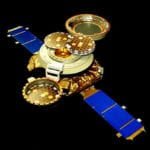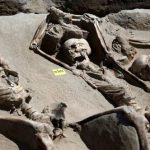 Mysteries
Mysteries  Mysteries
Mysteries  Music
Music 10 Musicians Who Changed How Everyone Plays Their Instruments
 Humans
Humans 10 Inventors Who Died Awful Deaths in Their Own Creations
 Animals
Animals 10 Ways Animals Use Deception to Survive
 Movies and TV
Movies and TV 10 Misdirections Directors Used to Manipulate Actors
 Politics
Politics The 10 Boldest Coup Attempts of the 21st Century
 Weird Stuff
Weird Stuff 10 Things That Would Have Killed You in the Old West
 Books
Books 10 Pen Names More Famous Than Their Authors
 Creepy
Creepy 10 Unnerving Legends from Around the World
 Movies and TV
Movies and TV 10 Amazing Lead Actor Ideas for Superhero Movies
 Mysteries
Mysteries 10 Bizarre, Little-Known Phenomena
 Music
Music 10 Musicians Who Changed How Everyone Plays Their Instruments
 Humans
Humans 10 Inventors Who Died Awful Deaths in Their Own Creations
Who's Behind Listverse?

Jamie Frater
Head Editor
Jamie founded Listverse due to an insatiable desire to share fascinating, obscure, and bizarre facts. He has been a guest speaker on numerous national radio and television stations and is a five time published author.
More About Us Animals
Animals 10 Ways Animals Use Deception to Survive
 Movies and TV
Movies and TV 10 Misdirections Directors Used to Manipulate Actors
 Politics
Politics The 10 Boldest Coup Attempts of the 21st Century
 Weird Stuff
Weird Stuff 10 Things That Would Have Killed You in the Old West
 Books
Books 10 Pen Names More Famous Than Their Authors
 Creepy
Creepy 10 Unnerving Legends from Around the World
 Movies and TV
Movies and TV 10 Amazing Lead Actor Ideas for Superhero Movies
Ten Most Expensive NASA Programs
It’s late at night on November 23, 2021, and you looked to the skies to see…something. At 10:20 pm, NASA launched its Double Asteroid Redirection Test (DART) mission. After liftoff on a Falcon 9 rocket from California’s Vandenberg Space Force Base, the spacecraft set out to travel millions of miles on a planetary defense test to…smash into an asteroid. The cost: $308 million! For intentionally destroying the craft, its only purpose: to see if it can alter the trajectory of that asteroid. (Couldn’t we get Bruce Willis and crew to do it for less?)
On October 1, 1958, NASA (National Aeronautics and Space Administration) became operational. The administration’s goals were grandiose right from the start: expand human knowledge of space, lead the world in space-related technological innovation, develop vehicles that can carry both equipment and living beings into space, and collaborate with international space agencies to achieve the most incredible scientific advancements possible.
NASA has accomplished each of these objectives during the last 60 years, and it continues to seek solutions to some of science’s most vexing questions as it adapts to a changing world. But at what cost?
In this list, we’ll take a look at some of NASA’s most expensive programs to date. While it may be easy to pick a favorite among NASA’s many accomplishments, the price tag might leave you wondering if the expense was really worth it.
Related: 10 Historical First Images Captured Of Space
10 Galileo, Estimated Cost: $1.6 Billion
Galileo, named after the great Italian scientist, began its journey toward the Solar System’s largest planet in 1989. In December 1995, it became the first-ever spacecraft to orbit the planet Jupiter. While the planet itself is fascinating (Galileo even witnessed the massive impact of comet Shoemaker-Levy 9), crucial information was gathered about its moons. One of which, Europa, with its seas of water hidden behind an icy crust, is one of the contenders to house life in our solar system.
Regrettably, Galileo’s fascinating journey couldn’t continue forever and, like most extraordinary things, unfortunately, had to come to an end. Galileo was terminated after nearly eight years in orbit by launching it into Jupiter’s atmosphere to avoid contaminating any of Jupiter’s moons with microbes that may have caught a ride from Earth.[1]
9 Alpha Magnetic Spectrometer, Estimated Cost: $2 Billion
The AMS-02 or Alpha Magnetic Spectrometer is an actual, highly complex piece of equipment that can be found on the International Space Station—delivered there by the Space Shuttle Endeavor in 2011. The AMS-02, created by Nobel Laureate and particle physicist Samuel Ting, is as advanced as anything you’ll find in a particle accelerator on Earth. It was designed to detect antimatter and find data that could help solve the puzzle of dark matter.
AMS-02 has collected data from over 175 billion cosmic ray occurrences during its lifetime and is still operational—despite its initial planned lifecycle of three years. In our quest to better understand our world, the considerable experiment has revealed antimatter in the form of both antiprotons and positrons. Antiprotons are protons’ antimatter complements, whereas positrons are electrons’ antimatter counterparts. Researchers discovered that high energy positrons are produced by various astronomical sources, such as cosmic ray collisions and dark matter, as opposed to high energy electrons, providing insight into the origins of these particles.[2]
8 Hubble Space Telescope, Estimated Cost: $2.5 Billion
The Hubble Space Telescope, named after Edwin Hubble, one of the best astronomers of the twentieth century, had a rocky start after being sent into orbit with an error that reduced the quality of the images it captured. The miscalculation was minuscule (on the range of microns, or approximately one-fiftieth the width of a human hair). Still, it happened to be devastating for the delicate piece of technology. As such, NASA had to send in astronauts to repair the flaw by inserting tiny mirrors into Hubble’s optical field. Hubble started working without a hiccup after that, and over the next two decades, the telescope has provided us with the most incredible photographs ever taken of our universe.
Hubble examines the cosmos 24 hours a day, seven days a week. That means it has witnessed some fantastic cosmic phenomenon every day of the year—for the past 31 years—including your birthday. If you haven’t looked at your birthday image on NASA’s website yet, we strongly advise you to do so because it makes for fascinating viewing.[3]
7 Curiosity, Estimated Cost: $2.5 Billion
Curiosity is beyond a doubt the most advanced probe to ever visit our planetary neighbor Mars, although it is by no means the first. At any moment of the day, you have the opportunity to look at the current terrain Curiosity is investigating as well as the weather it might be experiencing, and it’s incredible to see. Curiosity’s objective was to learn more about the planet’s geology and climate in order to address one of astronomy’s most pressing questions: is Mars suited for human life? And if it isn’t, was it suitable at some point in our past?
Up to this point, the answer to the first question is a definite no, while the answer to the second looks to be inconclusive. However, the notion that a high-tech robot is currently scouring the terrain and gathering data on another world is good enough, in our opinion, to justify the $2.5 billion price tag.[4]
6 Cassini-Huygens, Estimated Cost: $3.26 Billion
NASA launched the Cassini-Huygens mission in 1997 to explore Saturn, the most magnificent of the gas giants in our planetary system. The spacecraft was named after Italian and Dutch astronomers Giovanni Cassini and Christian Huygens. After a seven-year trip, Cassini was launched into orbit above Saturn and gathered vital information about the planet’s rings, satellites, and atmosphere.
Cassini’s passenger, the European Space Agency’s Huygens probe, detached from the primary craft on Christmas Day 2004 and successfully landed on Titan, one of Saturn’s moons. This was the first landing accomplished in the outer Solar System and the first landing on a moon other than our own. Cassini ran out of fuel after 20 years in space. NASA sent the spacecraft on a bold final mission to Saturn’s atmosphere to protect moons that might have circumstances favorable for life. On September 15, 2017, Cassini plummeted into Saturn’s atmosphere after nearly two dozen nail-biting dives between the planet and its icy rings, delivering research data to the very end.[5]
5 Global Positioning System, Estimated Cost: $12 Billion
The U.S. Air Force operates the Global Positioning System (GPS), a space-based radio navigation system controlled by the U.S. government. It can identify any three-dimensional location to meter-level exactness and time to 10-nanosecond reliability anywhere in the world—24 hours a day, 7 days a week. GPS is made up of three segments: the control segment, space segment, and user segment. To facilitate higher spacecraft autonomy and more sophisticated Earth tracking applications, NASA’s commitment to spearhead the future in scientific discovery, aeronautics research, and space exploration necessitates the proactive development and implementation of several GPS applications.
GPS’s origins can be traced back to the Sputnik era, when researchers discovered how to track satellites using shifts in its radio signal, referred to as the “Doppler Effect.” The Global Positioning System’s space segment currently consists of more than 30 fully functional satellites, each equipped with a redundant atomic clock and a ground control network that monitors the network 24/7.[6]
4 SLS and Orion, Estimated Cost: $23 Billion
The SLS, NASA’s Space Launch System, is a mega heavy-lift propulsion system developed by NASA that lays the groundwork for human space exploration beyond our solar system. The SLS is the only rocket with the power and capabilities to send the Orion spacecraft, complete with cargo and astronauts, to the Moon in a single mission, and it is set to launch in early 2022—for now.
NASA will use a configuration known as Block 1 for the launch of Artemis I, the first combined flight of SLS and Orion. The SLS will have a maximum thrust of 8.8 million pounds, 15% more than the Saturn V rocket. For Artemis I, the Block 1 configuration will send a crewless Orion spacecraft 40,000 miles further than the Moon (280,000 miles from Earth). Before NASA moves on to a crewed flight, engineers will monitor and modulate the integrated system performance of SLS, Orion, and its Exploration Ground Systems. If everything goes smoothly, the Artemis II mission will send astronauts on a flight to orbit the Moon, paving the way for the Artemis III mission to land astronauts on the Moon in 2024.[7]
3 Apollo Space Program, Estimated Cost: $110 Billion
The Apollo Program began in the 1960s, within the same lifetime as humankind’s first-ever flight. (link 16) NASA created the Apollo Command Module specifically for this program. It was a capsule that could accommodate up to three astronauts. The astronauts traveled to and from the Moon in the Command Module. It was far more extensive than the Mercury and Gemini spacecraft, and the astronauts inside had plenty of room to move about—depending on the notion of “plenty” as the crew space was about the size of a car.
The Lunar Module, a separate spacecraft, was utilized to land on the Moon. This craft transported astronauts from lunar orbit to the surface of the Moon and back to orbit. The Lunar Module itself only could transport two astronauts. As such, Buzz Aldrin and Neil Armstrong famously became the first humans to walk on the Moon in July 1969 during the Apollo 11 mission, just in time to keep President John F. Kennedy’s goal of placing a crew on the Earth’s natural satellite and safely returning them by the end of the decade. Perhaps the most outstanding achievement in history, the Apollo missions transported 24 people to the Moon (12 on its surface!) and remains the most ambitious expeditions ever attempted.[8]
2 International Space Station, Estimated Cost: $150 Billion
The International Space Station is a technical marvel and a symbol of what people from many different countries can do when working together. The International Space Station (ISS) is the largest artificial object in space (it can even be seen with the naked eye if the conditions are perfect!). It provides one-of-a-kind conditions for conducting scientific experiments and studying the effects of long periods in space on humans.
The International Space Station’s first component was launched into orbit by Russia in November 1998. The Russian Zarya control module was launched by a Russian rocket. Two weeks later, in orbit, the Space Shuttle Endeavour, carrying the U.S. Unity node, made contact with Zarya. The crew then connected the Zarya module to the Unity node. More pieces were added to the station over the next two years in order to make it habitable for our astronauts. The first live-aboard crew made their way to the International Space Station on November 2, 2000, and astronauts from nations all over the world have called it home for limited periods of time ever since.[9]
1 Space Shuttle Program: $209 Billion
The Space Shuttle Program in the 1970s gave birth to the world’s first orbital space shuttle that could be reused (instead of rockets, which could only be used once and were disposed of after each launch). It consisted of an external tank, two external rockets or boosters, and the famous orbiter vehicle, one of the most well-known feats of engineering ever constructed.
Five orbiters were built throughout the project’s three decades of activity: Atlantis, Endeavour, Discovery, Challenger, and Columbia. Unfortunately, the last two were destroyed during operations—the only significant mishaps in an otherwise successful sequence of missions.
The Space Shuttle Program cost between $196 and $209 billion (NASA’s official estimate) and had 135 launches, at the cost of more than $1.5 billion per launch. The Shuttle program was succeeded by the SLS (Space Launch System) just two months after the program’s last mission, which took place in July 2011.[10]








